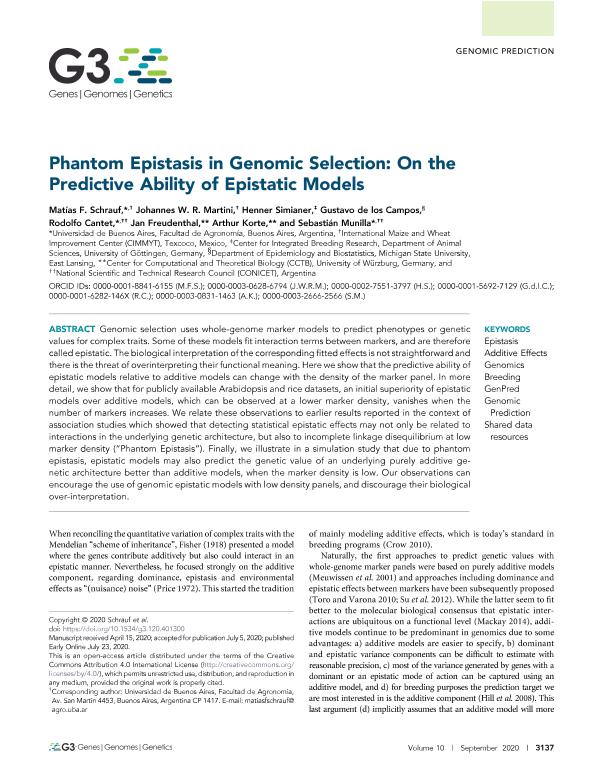Artículo
Phantom epistasis in genomic selection: on the predictive ability of epistatic models
Schrauf, Matías Florián ; Martini, Johannes W.R.; Simianer, Henner; de los Campos, Gustavo; Cantet, Rodolfo Juan Carlos
; Martini, Johannes W.R.; Simianer, Henner; de los Campos, Gustavo; Cantet, Rodolfo Juan Carlos ; Freudenthal, Jan; Korte, Arthur; Munilla Leguizamon, Sebastian
; Freudenthal, Jan; Korte, Arthur; Munilla Leguizamon, Sebastian
 ; Martini, Johannes W.R.; Simianer, Henner; de los Campos, Gustavo; Cantet, Rodolfo Juan Carlos
; Martini, Johannes W.R.; Simianer, Henner; de los Campos, Gustavo; Cantet, Rodolfo Juan Carlos ; Freudenthal, Jan; Korte, Arthur; Munilla Leguizamon, Sebastian
; Freudenthal, Jan; Korte, Arthur; Munilla Leguizamon, Sebastian
Fecha de publicación:
01/09/2020
Editorial:
Genetics Society of America
Revista:
G3: Genes, Genomes, Genetics
ISSN:
2160-1836
Idioma:
Inglés
Tipo de recurso:
Artículo publicado
Clasificación temática:
Resumen
Genomic selection uses whole-genome marker models to predict phenotypes or genetic values for complex traits. Some of these models fit interaction terms between markers, and are therefore called epistatic. The biological interpretation of the corresponding fitted effects is not straightforward and there is the threat of overinterpreting their functional meaning. Here we show that the predictive ability of epistatic models relative to additive models can change with the density of the marker panel. In more detail, we show that for publicly available Arabidopsis and rice datasets, an initial superiority of epistatic models over additive models, which can be observed at a lower marker density, vanishes when the number of markers increases. We relate these observations to earlier results reported in the context of association studies which showed that detecting statistical epistatic effects may not only be related to interactions in the underlying genetic architecture, but also to incomplete linkage disequilibrium at low marker density (“Phantom Epistasis”). Finally, we illustrate in a simulation study that due to phantom epistasis, epistatic models may also predict the genetic value of an underlying purely additive genetic architecture better than additive models, when the marker density is low. Our observations can encourage the use of genomic epistatic models with low density panels, and discourage their biological over-interpretation.
Archivos asociados
Licencia
Identificadores
Colecciones
Articulos(INPA)
Articulos de UNIDAD EJECUTORA DE INVESTIGACIONES EN PRODUCCION ANIMAL
Articulos de UNIDAD EJECUTORA DE INVESTIGACIONES EN PRODUCCION ANIMAL
Citación
Schrauf, Matías Florián; Martini, Johannes W.R.; Simianer, Henner; de los Campos, Gustavo; Cantet, Rodolfo Juan Carlos; et al.; Phantom epistasis in genomic selection: on the predictive ability of epistatic models; Genetics Society of America; G3: Genes, Genomes, Genetics; 10; 9; 1-9-2020; 3137-3145
Compartir
Altmétricas



